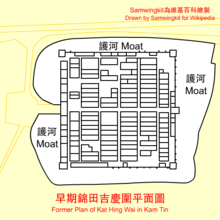Kat Hing Wai
Kat Hing Wai (Chinese: 吉慶圍) is a Punti walled village in the Yuen Long District of Hong Kong. The village is popularly known as Kam Tin, from the name of the local area. Kat Hing Wai is home to about 400 descendants of the Tang Clan, one of the "Five Great Clans" of the territory who settled here from China during the Song Dynasty.[1] The village walls were added in the 17th century.[2] The Tangs are Punti people descended from Southern China and were the first to settle in Hong Kong.[3] Kat Hing Wai's residents speak the Weitou dialect, a Yue dialect.
.jpg)

.jpg)


Three other walled villages, Wing Lung Wai, Tai Hong Wai, and Kam Hing Wai are located nearby and were built around the same time.[4]
History
Kat Hing Wai was established during the reign of the Ming Chenghua Emperor (r. 1464–1487). The walls enclosing Kat Hing Wai were built by Tang Chue-yin (鄧珠彥) and Tang Chik-kin (鄧直見) in the early years of the Kangxi reign (1661–1722) of the Qing dynasty.[5]
The Six-Day War (1899) was fought between the British Empire and the major punti clans of the New Territories in Hong Kong on 14–19 April 1899. The Tang Clan rebelled against British Colonial rule and defended themselves in Kat Hing Wai. After several unsuccessful attacks by British troops, the iron gates were blasted open and the gates were then shipped to London for exhibition. Following demands from the Tang Clan in 1924, the gate was eventually returned in 1925 by the 16th governor, as a celebration, Kat Hing Wai displays a tablet as an account of this incident by the entrance. Because of this, Kat Hing Wai became a very unique place where have a strong icon in both architectural and historical background to be studied.[6]
Features
Kat Hing Wai is a quasi-rectangular (100 by 90 metres (330 by 300 ft)) walled village with seven meters high brick walls, originally used to protect from pirates and another clans' invasion. The village area is about eighty-meter square. As a family stronghold, Kat Hing Wai has served the Tangs well through the centuries, protecting the residents against bandits, rival clans, and wild tigers. During the Qing dynasty, a five-metre high blue brick wall and four cannon towers were added to defend against bandits. Today, the village is still completely surrounded by 18-inch-thick walls, outside which are the remains of a moat. However, most houses within the walls have been rebuilt in recent years.
There is only one narrow entrance, with a pair of iron gates that were removed by the British in 1899 and only one was eventually returned in 1924. The current standing gates are a mismatched pair, the left hand side originally belongs to Tai Hong Wai and was given to Kat Hing Wai as a gift when the right gate was returned.
Conservation
Kat Hing Wai is a private property and the Government has not yet obtained the consent of its owners to declare it as a monument.[7]
Access
Route: West Rail line Kam Sheung Road Station or Kowloon Motor Bus bus routes 51, 54, 64K and 251M.[6]
See also
References
- Hong Kong Museum of History
- Hong Kong Museum of History
- Hong Kong Museum of History
- Introduction to 1444 Historic Buildings. Item #505
- "Brief Information on Proposed Grade I Items" (PDF). Archived from the original (PDF) on 16 October 2012. Retrieved 19 January 2011.
- discoverhongkong.com (see this page for access details)
- LCQ7: Developing Kat Hing Wai into tourist site April 24, 2002
External links
| Wikimedia Commons has media related to Kat Hing Wai. |